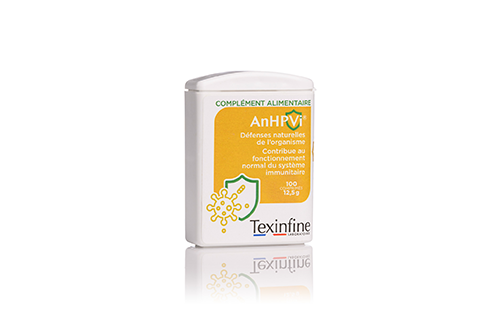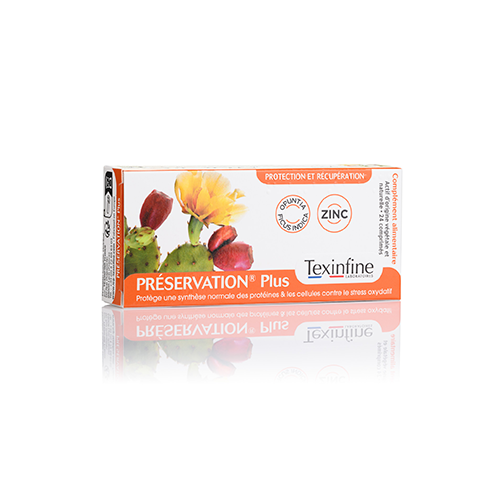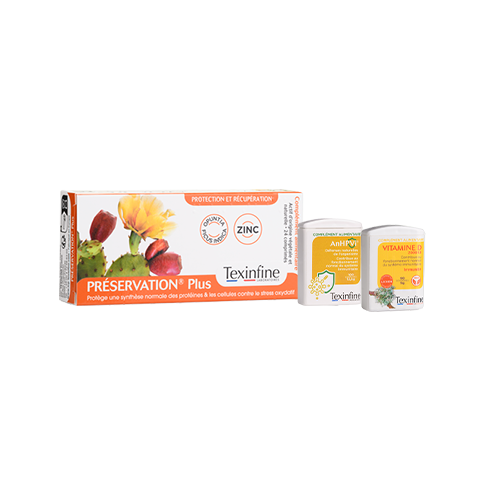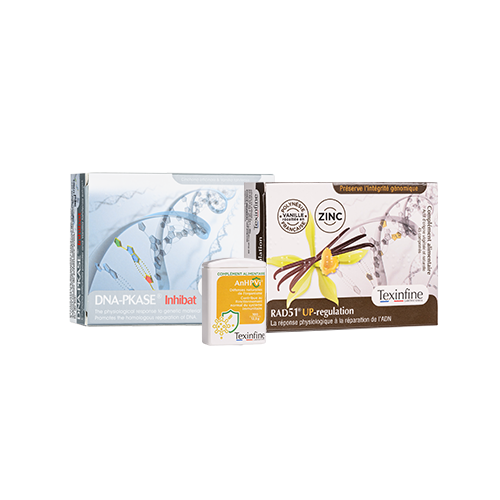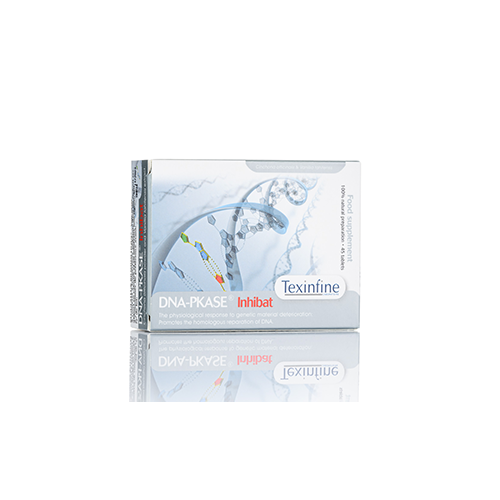ANHPVi®
AnHPVi® is a uniquely designed food supplement contributing to fight against viral infection and aid the immune system.
AnHPVi® contains a combination of natural extracts from Pomegranate, Punica granatum CAE™, basil Ocimum basilicum OBE™ and honey MAEE™ with the addition of the vitamin B6 making AnHPVi® highly effective to support natural defences. Vitamin B6 present in AnHPVi® plays a key role in the production of T lymphocytes and interleukins where its deficiency leads to a decrease in immunity.
The extracts present in AnHPVi® offers a unique and natural combination of bioactive compounds targeting multiple antiviral mechanisms of action for an optimum cell protection.
- Pomegranate skin extract is rich in polyphenols, particularly ellagic acid and punicalagins, which has the potential to interfere with viral attachment and entry into host cells, thus disrupting the viral life cycle.
- The aromatic extract of basil contains an array of bioactive compounds some such as eugenol, rosmarinic acid and caffeic acid which have demonstrated in scientific studies an antiproliferative and antiviral properties by inhibiting the replication of certain viruses.
- Honey extract contains bioactive compounds like flavonoids known to substantially promote autophagy, a powerful defense cellular tool against viral infection.
FORM AND PRESENTATION:
Box of 100 tablets of 125 mg each.
WHO SHOULD TAKE AnHPVi®?
This food supplement is recommended to support the immune system and strengthen the natural defences : To help prevent, treat and eliminate reoccurring viral infections of Human Papilloma Virus (HPV) and Human Cytomegalovirus (HCMV) type viruses.
- Persons suffering from re-occurring herpes outbreaks such as cold sores.
- Partners of persons with herpes infections.
- Women detected with HPV infection following a cervical swab.
- Partners of women with HPV infections.
THE STRENGTH OF AnHPVi®: Quality & Innovation
The quality of TEXINFINE laboratory products is our highest priority.
Laboratoire Texinfine's commitments:
- Environmental: Our extracts are sourced from cultivated plants to protect natural resources.
- Quality: A series of quality control tests are performed on the initial plant to test for the presence of any unwanted contaminants : heavy metals, aflatoxins, pesticides, cytotoxicity…
- Innovation: We have developed our own active ingredients of plant origin, thereby guaranteeing active, natural products.
- Efficacy : The biological activity of our plant extracts is controlled in our in house laboratories to determine and adjust the needed quantity for each batch. The single extracts and combination of extracts contained in AnHPVi® are tested for their efficacy to prevent infection of healthy cells and reduce propagation of infected cells in cell culture models.
AnHPVi® is specifically formulated to support the body’s immune system to avoid infection through the potent combination of multiple natural plant extracts. Our in house cell culture trials have shown that the combination of the extracts of the Punica granatum (Pomegranate), Ocimum basilicum (Basil) and honey are highly effective at preventing infection of cells against Human Papilloma Virus (HPV) and Human Cytomegalovirus (HCMV; the family viruses that the herpes virus is a part of). Our tests have shown that the combination of these extracts not only stops the propagation of the infection with these viruses but also that if taken in prevention, the virus will be blocked from attaching to the host cell all together, thereby promoting an optimum protection against viral infection.
A virus enters a human cells by attaching to the cell receptors, followed by multiple steps leading to the transfer of the viral genome into the host cells.
Attachment and entry
In order to infect a cell and start viral replication, the first key step is the attachment and entry of the virus into the host cell. This is the most crucial step as an inhibition of attachment and entry will inevitably protect the cell from any further damage due to viral activity. Once the virus has penetrated the cell wall and inserted its genetic information into the host cell the next key step in viral replication is to keep its genetic information safe.
Selected extract of Punica granatum CAE® has shown to be highly active to inhibit attachment and entry of HCMV and HPV into host cells, thereby eliminating the majority of pathogens even before infection and protecting the cell from any further harmful processes.
First phase elimination of viral particles through autophagy processes
Normally, foreign particles are detected by the host-cell defense system and eliminated through the cells cleaning processes, also called autophagy. It has been shown that herpesviridae as well as papillomaviridae have the ability to inhibit this important process of autophagy and thereby ensure that the genetic information can be transported to its target location, transcribed and translated.
Extract of honey MAEE™ has been shown to enhance markers for autophagy processes and has therefore the potential to help the cells defense mechanisms to re-establish the natural autophagy processes which will help to eliminate viral particles before and after the nucleic phase.
Protection of the host cell’s nucleic balance
The transcription and translation of the viral genetic information depends strongly on the type of its genome, described by the classification of Baltimore. In general terms speaking, viruses can contain RNA or DNA in single or double strand. Both, herpesviridae and papillomaviridae contain double stranded DNA and belong to Class I of the Baltimore classification. As such their genetic information has to enter the host cell’s nucleus in order to be transcribed into RNA which is then used to produce viral proteins. To ensure optimal replication of their genetic information, viruses fundamentally alter processes in the host cell’s nuclei, one of which is an increase in nucleic DNAPK, a complex responsible for the non-homologue DNA repair.
Extract of Ocimum basilicum OBE™ has shown to inhibit DNAPK and thereby maintain the base level of these complexes in the cells core, thereby normalizing non-homologues repair processes of DNA and reducing the virus’ ability to transcribe its DNA.
Second phase of elimination of viral particles through autophagy
After successful transcription and translation of the viral genetic information in the host cell’s core, the single viral particles have to be assembled and copies of the genome enclosed. This process takes place in the cytoplasm with the help of the endoplasmic reticulum and the golgi apparatus. During this stage, the viral capability to inhibit autophagy processes is once again used to avoid elimination of viral particles.
By the natural presence flavonoids, including quercetin, Honey extract MAEE™ encourage the autophagy process enabling a cell to eliminate impurities or damage, contributing to the body's recovery and protection during viral infection.
Release of viral particles and transport to other tissues
The release of infectious viral particles into the extracellular space, enabling further infection of neighboring cells or transport through the bloodstream to other tissues.
The hidden dangers of chronic viral infections.
When the viral genetic information is integrated into a cell, this integration changes its normal sequence. It is well understood that a change on the DNA code, also called mutation, can have different consequences. If the sequence of a non-coding region is affected (a region that will not be translated into a protein), the effects are limited. If, however, a coding region is affected the effects can be serious, especially when proteins or enzymes are involved that regulate the cell cycle and proliferation. Viruses that do integrate their genetic information into the host cell’s DNA (like HPV and herpes virus) prefer to do so in coding regions. A potential reason for this is that the viral genetic information thereby has better access to important promoter regions.
Promoter regions are those parts of the DNA that regulate the transcription of the following DNA sequence until a terminator region is reached. Due to this preference of viruses to infiltrate coding regions of the DNA, the risk of the mutation of important cell cycle functions is increased.
With re-occurring outbreaks and new infection of cells, the risk increases that one of these mutation will lead to a cell with uncontrolled cell division, also called tumour or cancer. It is due to this risk that gynaecologists often recommend the removal of affected tissues of the cervix of woman showing HPV infection. Similarly, herpes infections can lead to cancers in the throat or other tissues with re-occurring outbreaks.
DIRECTION FOR USE:
For ENT sites: 2 tablets taken orally (sublingually), 3 to 5 times a day, for 5 days.
For other sites: between 6 and 10 tablets in a single oral (sublingual) dose, for 5 days.
Intake varies according to weight:
- 6 tablets (P < 60 Kg)
- 8 tablets (60 Kg < P < 80 Kg)
- 10 tablets (80 Kg < P < 100 Kg)
If you have received other recommendations from your healthcare professional, we invite you to follow them, as they are adapted to your case, unlike our generic dosages.
COMPOSITION FOR 10 TABLETS:
Active ingredients: Punica granatum extract (Pomegranate; 50mg), Ocimum basilicum extract (Basil; 90mg), honey extract (1mg) and Vitamin B6 (1mg or 100% NRV*).
*Nutritional reference values
Other ingredients: Magnesium stearate, Dextrose.
NOTES:
- In the current state of our knowledge, no adverse effects associated with AnHPVi® food consumption have been reported.
- This food preparation contains no preservatives or synthetic additives.
- Calorie content not significant.
- This food supplement is to be consumed as part of and should not replace a full, varied and balanced diet.
- Store at room temperature in a dry place.
- Keep out of reach of young children.
- Do not use prolonged use.
- Not recommended for children.
As legislation does not allow us to communicate on the properties of certain plants and active ingredients, we advise you to consult existing literature for more information.









































































